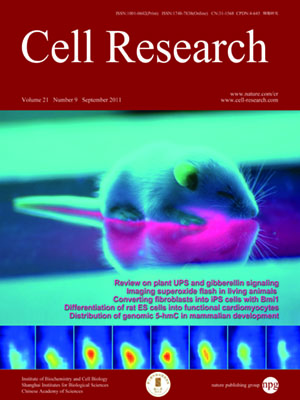
Volume 21, No 9, Sep 2011
ISSN: 1001-0602
EISSN: 1748-7838 2018
impact factor 17.848*
(Clarivate Analytics, 2019)
Volume 21 Issue 9, September 2011: 1295-1304
ORIGINAL ARTICLES
Imaging superoxide flash and metabolism-coupled mitochondrial permeability transition in living animals
Huaqiang Fang1,2,*, Min Chen1,*, Yi Ding1, Wei Shang1, Jiejia Xu1, Xing Zhang3, Wanrui Zhang1, Kaitao Li1, Yao Xiao1, Feng Gao3, Shujiang S
1Institute of Molecular Medicine, College of Life Science, Peking University, Beijing 100871, China
2State Key Laboratory of Biomembrane and Membrane Biotechnology, College of Life Science, Peking University, Beijing 100871, China
3Department of Physiology, The Fourth Military Medical University, Xi'an 710023, China
4Department of Molecular Biophysics and Physiology, Rush University School of Medicine, Chicago, IL 60612, USA
5Department of Physiology and Biophysics, Robert Wood Johnson Medical School, Piscataway, NJ 08854, USA
6Department of Medicine, University of California, San Diego, CA 92093, USA
7Mitochondria and Metabolism Center, Department of Anesthesiology and Pain Medicine, University of Washington, Seattle, WA 98109, USA
Correspondence: Heping Cheng, Xiuqin Zhang,(chengp@pku.edu.cn; zhangxq@pku.edu.cn)
The mitochondrion is essential for energy metabolism and production of reactive oxygen species (ROS). In intact cells, respiratory mitochondria exhibit spontaneous “superoxide flashes”, the quantal ROS-producing events consequential to transient mitochondrial permeability transition (tMPT). Here we perform the first in vivo imaging of mitochondrial superoxide flashes and tMPT activity in living mice expressing the superoxide biosensor mt-cpYFP, and demonstrate their coupling to whole-body glucose metabolism. Robust tMPT/superoxide flash activity occurred in skeletal muscle and sciatic nerve of anesthetized transgenic mice. In skeletal muscle, imaging tMPT/superoxide flashes revealed labyrinthine three-dimensional networks of mitochondria that operate synchronously. The tMPT/superoxide flash activity surged in response to systemic glucose challenge or insulin stimulation, in an apparently frequency-modulated manner and involving also a shift in the gating mode of tMPT. Thus, in vivo imaging of tMPT-dependent mitochondrial ROS signals and the discovery of the metabolism-tMPT-superoxide flash coupling mark important technological and conceptual advances for the study of mitochondrial function and ROS signaling in health and disease.
Cell Research (2011) 21:1295-1304. doi:10.1038/cr.2011.81; published online 10 May 2011
FULL TEXT | PDF
Browse 2405


